At its core, Kickstarter is a crowdfunding website that empowers creators to bring their innovative projects to life through the direct support of backers. From breakthrough tech gadgets to tabletop role-playing games and everything in between, Kickstarter has become a beacon for creators and supporters of unique projects worldwide. It serves as a stage where creators can present their project ideas to the public and solicit financial support from backers who are interested in helping to bring those projects to fruition. It's not just a funding mechanism—it's a community of enthusiasts who rally around creative ideas.
Kickstarter operates on an all-or-nothing funding model. Basically, a creator will post their project, which takes a large number of steps that I will be getting into in a later post. The most important parts of those steps are creating a funding goal and a product page where people will come to take a look and see if the project is something they want to back or not.
Kickstarters have a time limit during which creators will work to get pledges. If they do not reach their funding goal, any pledges made during the Kickstarter won’t be charged to backers. If they do reach their funding goal, backers are charged after the campaign closes, and it will now be the creator’s job to deliver their project.
With that said, Kickstarter works a lot like very small scale angel investing in that the money given to creators is basically given to them with no promise of them ever delivering. Yes, you read that right. A creator on Kickstarter has absolutely no legal obligation to deliver the project you backed. You are paying for the idea and the hope that the project will be manufactured.
I know that probably sounds scary, but the good news is that the vast majority of projects that do reach their funding goal do actually get produced. There is a very small percentage of creators that never deliver, and these are typically new creators that do not budget for production appropriately. While you should never let fear keep you from backing a new creator, if you are the super cautious type, you can avoid this by looking at a creator’s history on Kickstarter, seeing how many Kickstarters they’ve run and how many they’ve delivered on.
After a Kickstarter is funded, you might expect that you would get the product delivered immediately, but that is usually not the case. Remember, the whole point of a creator running a Kickstarter is to fund their vision, which means, a lot of times, the product you’re backing hasn’t gone into manufacturing yet. In some cases, it could just be a scribble on some notebook paper. That’s why it’s important to check out a project’s estimated delivery date before you back anything. This is the date at which the creator expects the product to be completed and ready to ship. These dates are typically an estimate and often not entirely accurate. Many creators, like myself, tend to deliver early, as it’s smart to build in time for things to go wrong. But some creators do deliver late because they don’t do this. With that said, the best way to know when you’ll get your product is to read any project updates that the creator posts on Kickstarter.
Depending on the product, you will also likely get a backer survey from either Kickstarter or Backerkit asking for whatever information is required to process your order. Shipping can be charged at the time you place your order or closer to the delivery date. It really just depends on the project, so make sure you’re aware of that and not surprised when, several months down the road, your credit card is hit with a random charge because the creator charged for shipping. Most creators should post a Kickstarter update before they do this, but some don’t, so it’s a good thing to be aware of.
So many successful businesses have been launched because of Kickstarter, including my own. It’s a really great place for a creator to test their ideas and see if there is a market for them, and it’s also a great place for consumers to get their hands on products that may not ever make it to a wider market. For instance, I back a lot of board games that may not ever get a retail presence. If you’re a creator, it’s definitely worth running one. Doing it has completely changed my life for the better. If you’re a consumer, it allows you to help fund someone else’s dream while also being a part of it, which is a really cool experience in and of itself.
